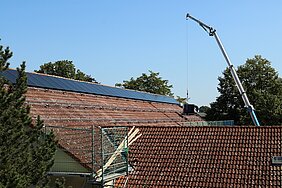The Leibniz Institute for Agricultural Engineering and Bioeconomy (ATB) has successfully completed two major projects in recent months: the installation of a high-performance photovoltaic system on several building roofs on the campus in Potsdam Bornim and the refurbishment of part of the archive.
A treasure in the cellar
Before the first solar modules could be installed on the roofs, an extensive clean-up operation had to be carried out in the archive and cellar.
Students on the "Archive" and "Library Science" degree programmes at the Potsdam University of Applied Sciences, together with their supervisors Ingrid Kohl, Geheimes Staatsarchiv Preußischer Kulturbesitz, and Sabine Stropp, Landesfachstelle für Archive und Öffentliche Bibliotheken at the Potsdam University of Applied Sciences, supported the core team responsible at ATB in examining the library holdings, some of which are valuable.
Over 2000 reports from the former Institute of Agricultural Engineering Bornim have already been scanned, catalogued and are available online. The students' task was now to develop a concept for the long-term archiving of around 500 further research reports from the Schlieben-Bornim Research Centre for Mechanisation and Energy Application in Agriculture from 1977 to 1991. All of the reports are unique and irreplaceable items that have so far been inadequately stored in hanging files.
The extensive work was led by Dr Martin Geyer and carried out with the active support of our young people in their voluntary social year. Our colleagues in the finance and HR departments, who sifted through and disposed of documents that were time-barred, should not go unmentioned.
Alice Hohn, Administrative Director at ATB, thanks the entire team: "This project is also proof of the great cooperation within ATB and beyond. Our heartfelt thanks go to the colleagues who have actively participated."
Solar energy for a sustainable energy supply
Work on four roofs progressed in parallel to the work in the basement: our new photovoltaic system comprises 450 kWp of solar modules with a total surface area of 2615m2. By connecting the more than 1,000 modules in pairs and using optimisers, energy generation is maximised and safety is increased in the event of a fire. With the new photovoltaic system, ATB is expected to cover around 34 per cent of the institute's annual electricity requirements. This not only reduces the ATB's ecological footprint, but also its operating costs.
"With this installation, we are making an important contribution to climate protection and setting an example for sustainability," emphasises Alice Hohn. “We would like to thank the Ministry for Science, Research and Culture (MWFK) for the funding as part of the 'Brandenburg Paket'.”
In early December, a high-performance electricity storage unit with a capacity of 1,288 kWh was installed as the final component. The impressive storage unit, which weighs 11 tons and has an output of 736 kW, is now ready to store the electricity generated by the new photovoltaic system and further optimize the energy supply at ATB.




